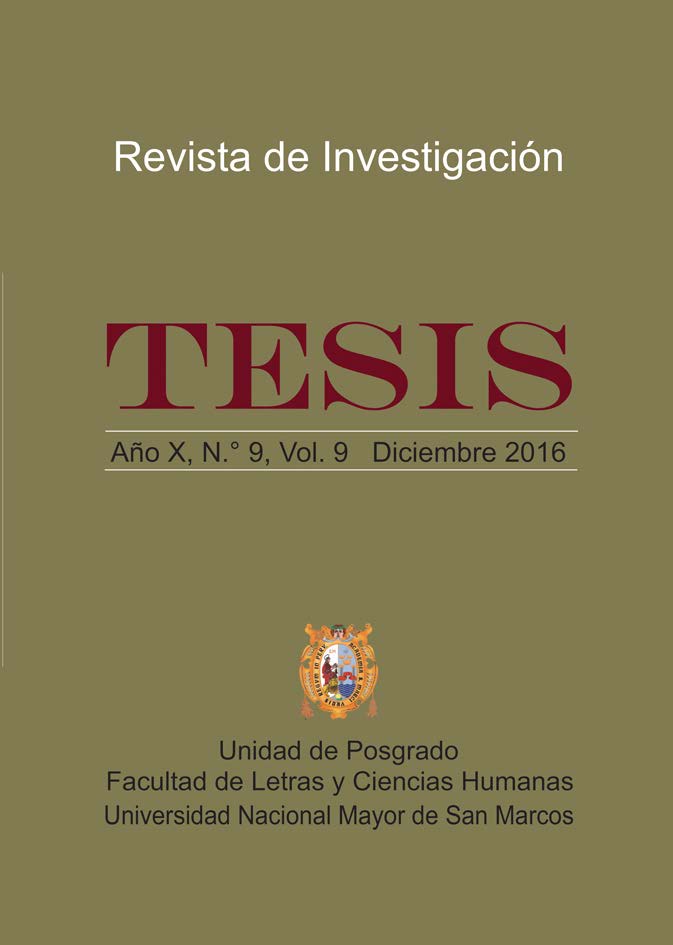A story about the years of political violence: "My Brother Alberto" by Jorge Ninapayta
DOI:
https://doi.org/10.15381/tesis.v9i9.23504Keywords:
Ninapayta, “Mi hermano Alberto”, fictional inmersion, saturation functionAbstract
In this article ask about fictional worlds of the story “Mi hermano Alberto” of Jorge Ninapayta whose genesis and implicit references have as background the years of political violence from the eighties that suffered Peru. For our approach the methodological tool of the poetry fiction inmersion developed by Ryan in her book Narrative as Virtual Reality. Inmersion and Interactivity in Literature and Electronic Media (2004); as well as the saturation function raised by Dolezel in Heterocosmica: Fiction and Possible Worlds (1999). Throeugh such instruments will seek to bring to light the constituent elements of fictional worlds to prove that “Mi hermano Alberto” is a text that with a strategic dosage of explicit and impliciti elements has a high potential to provoke the fictional inmersion of the reader and therefore to fulfill other functions transcendent of the fiction.
References
Ninapayta, Jorge. (2000). Muñequita linda. Lima: Jaime Campodónico Editor.
Ninapayta, Jorge. (1988). Mi hermano Alberto. En Universidad Nacional Mayor de San Marcos. (comp.). Siete cuentos para Borges. I Concurso Literario de Cuento “Jorge Luis Borges 1987”. (pp.5-14). Lima: UNMSM. Facultad de Letras y Ciencias Humanas.
Ninapayta, Jorge. (1988). Mi hermano Alberto. Fin de siglo. (3), 27-33.
Ninapayta, Jorge. (1997). Mi hermano Alberto. En Juan Antonio Bravo (comp.). Últimos y recientes narradores nacidos entre 1950-1965. (pp.212-221). Lima: Banco Central de Reserva.
Cox, Mark. (2008). Bibliografía anotada de la ficción narrativa peruana sobre la guerra interna de los años ochenta y noventa (con un estudio previo), Revista de crítica literaria latinoamericana. (68), 227-268.
González Vigil, Ricardo. (2001). Jorge Ninapayta. En El Cuento Peruano 1990-2000. (pp.632-633). Lima: Petróleos del Perú.
Martos, Marcos. (2000). Gemas literarias. Muñequita linda, Debate, (11), 72-73.
Menton, Seymour. (2001). Munequita linda. Book review, World Literature Today, Oklahoma: University of Oklahoma, Vol. 75, (1), 178-179.
Niño de Guzmán, Guillermo (comp.) (1987). En el camino. Nuevos cuentistas peruanos. Lima: Instituto Nacional de Cultura.
Ruiz Ayala, Iván (2003). Perú: La década de la barbarie. Pesimismo y acrimonia en los cuentos de Jorge Ninapayta, Georgia College (?), 159-177. Recuperado de: https://www.ajlas.org/v2006/pdf
Dolezel, Lubomír. Heterocósmica. (1999). Ficción y mundos posibles. Madrid: Arco/Libros.
Reis, Carlos y Lopes, Ana Cristina. (2002). Diccionario de narratología. Salamanca: Ediciones del Colegio de España.
Ryan, Marie-Laure. (2004). La narración como realidad virtual. La inmersión y la interactividad en la literatura y en los medios electrónicos. Barcelona: Paidós.
Sábato, Ernesto. (2006). El escritor y sus fantasmas. Buenos Aires: Seix Barral.
Schaeffer, J.-M. (2002) ¿Por qué la ficción? Madrid: Lengua de Trapo.
Downloads
Published
Issue
Section
License
Copyright (c) 2016 Luis Jaime Díaz Meléndez

This work is licensed under a Creative Commons Attribution 4.0 International License.
THE AUTHORS RETAIN THEIR RIGHTS:
(a) The authors retain their trademark and patent rights, and also on any process or procedure described in the article.
(b) The authors retain the right to share, copy, distribute, execute and publicly communicate the article published in Tesis (Lima) (in example, depositing the article in an institutional repository or publish it in a book), with recognition of its initial publication in the Tesis (Lima).
(c) The authors retain the right to make a later publication of their work, to use the article or any part of it (for example: a compilation of their works, notes for conferences, thesis, or for a book), provided that they indicate the source of publication (authors of the work, magazine, volume, number and date).






